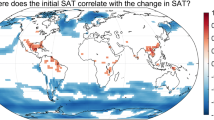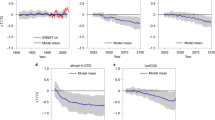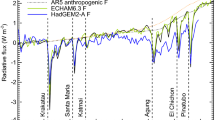Abstract
The change in the Earth's equilibrium global mean surface temperature induced by a doubling of the CO2 concentration has been estimated as 0.2 to 10 K by surface energy balance models, 0.5 to 4.2 K by radiative-convective models, and 1.3 to 4.2 K by general circulation models. These wide ranges are interpreted and quantified here in terms of the direct radiative, forcing of the increased CO2, the response of the climate system in the absence of feedback processes, and the feedbacks of the climate system. It is the range in the values of these feedbacks that leads to the ranges in the projections of the global mean surface warming. The time required for a CO2-induced climate change to reach equilibrium has been characterized by an e-folding time τe with values estimated by a variety of climate/ocean models as 10 to 100 years. Analytical and numerical studies show that this wide range is due to the strong dependence of τe on the equilibrium sensitivity of the climate model and on the effective vertical thermal diffusivity of the ocean model. A coupled atmosphere-ocean general circulation model simulation for doubled CO2 suggestes that, as a result of the transport of the CO2-induced surface heating into the interior of the ocean, τe ≅ 50 to 100 years. Theoretical studies for a realistic CO2 increase between 1850 and 1980 indicate that this sequestering of heat into the ocean's interior is responsible for the concomittant warming being only about half that which would have occurred in the absence of the ocean. These studies also indicate that the climate sytem will continue to warm towards its as yet unrealized equilibrium temperature change, even if there is no further increase in the CO2 concentration.
Similar content being viewed by others
References
Augustsson T, Ramanthan V (1977) A radiative-convective model study of the CO2 climate problem. J Atmos Sci 34: 448–451
Broecker WS, Peng T-H, Engh R (1980) Modeling the carbon system. Radiocarbon 22: 565–598
Bryan K, Komro FG, Manabe S Spelman MJ (1982) Transient climate response to increasing atmospheric carbon dioxide. Science 215: 56–58
Bryan K, Komro FG, Rooth C (1984) The ocean's transient response to global surface temperature anomalies. In: Hansen JE, Takahashi T (eds) Climate Processes and Climate Sensitivity, Maurice Ewing Series, 5. American, Geophysical Union, Washington DC, pp 29–38
Budyko MI (1969) The effect of solar radiation variations on the climate of the earth. Tellus 21: 611–619
Callendar GS (1938) The artificial production of carbon dioxide and its influence on temperature. Q J Meteor Soc 64: 223–240
Charlock TP (1981) Cloud optics as a possible stabilizing factor in climate change. J Atmos Sci 38: 661–663
Elliott WP, Machta L, Keeling CD (1985) An estimate of the biotic contribution to the atmospheric CO2 increase based on direct measurements at Mauna Loa Observatory. J Geophys Res 90: 3741–3746
Gates WL (1976a) Modeling the ice-age climate. Science 191: 1138–1144
Gates WL (1976b) The numerical simulation of ice-age climate with a global general circulation model. J Atmos Sci 33: 1844–1873
Gates WL, Han Y-J, Schlesinger ME (1985) The global climate simulated by a coupled atmosphere-ocean general circulation model: Preliminary results. In: JCJ Nihoul (ed) Coupled Ocean-Atmosphere Models. Elsevier, Amsterdam, pp 131–151
Ghan SJ, Lingaas JW, Schlesinger ME, Mobley RL, Gates WL (1982) A documentation of the OSU two-level atmospheric general circulation model. Report No. 35, Climatic Research Institute, Oregon State University, Corvallis, OR, 395 pp
Hall MCG, Cacuci DG, Schlesinger ME (1982) Sensitivity analysis of a radiative-convective model by the adjoint method. J Atmos Sci 39: 2038–2050
Han Y-J (1984a) A numerical world ocean general circulation model. Part I. Basic design and barotropic experiment. Dyn Atmos Oceans 8: 107–140
Han Y-J (1984b) A numerical world ocean general circulation model. Part II. A baroclinic experiment. Dyn Atmos Oceans 8: 141–172
Han Y-J, Schlesinger ME, Gates WL (1985) An analysis of the air-sea-ice interaction simulated by the OSU coupled atmosphere-ocean general circulation model. In: JCJ Nihoul (ed) Coupled Ocean-Atmosphere Models. Elsevier, Amsterdam, pp 167–182
Hansen J, Johnson D, Lacis A, Lebedeff S, Lee P, Rind D, Russell G (1981) Climate impact of increasing atmospheric carbon dioxide. Science 213: 957–966
Hansen J, Lacis A, Rind D, Russell G, Stone P, Fung I, Ruedy R, Lerner J (1984) Climate sensitivity: Analysis of feedback mechanisms. In: Hansen JE, Takahashi T (eds) Climate Processes and Climate Sensitivity. Maurice Ewing Series, 5, American Geophysical Union, Washington DC, pp 130–163
Harvey LDD (1986) Effect of ocean mixing on the transient climate response to a CO2 increase: analysis of recent model results. J Geophys Res 91: 2709–2718
Hoffert MI, Callegari AJ, Hsieh C-T (1980) The role of deep sea heat storage in the secular response to climate forcing. J Geophys Res 85: 6667–6679
Hummel JR (1982) Surface temperature sensitivities in a multiple cloud radiative-convective model with a constant and pressure dependent lapse rate. Tellus 34: 203–208
Hummel JR, Kuhn WR (1981a) Comparison of radiative-convective models with constant and pressure-dependent lapse rates. Tellus 33: 254–261
Hummel JR, Kuhn WR (1981b) An atmospheric radiative-convective model with interactive water vapor transport and cloud development. Tellus 33: 372–381
Hummel JR, Reck RA (1981) Carbon dioxide and climate: The effects of water transport in radiative-convective models. J Geophys Res 86: 12035–12038
Hunt BG (1981) An examination of some feedback mechanisms in the carbon dioxide climate problem. Tellus 33: 78–88
Hunt BG, Wells NC (1979) An assessment of the possible future climate impact of carbon dioxide increases based on a coupled one-dimensional atmospheric-oceanic model. J Geophys Res 84: 787–791
Imbrie J, Imbrie KP (1979) Ice Ages, Solving the Mystery. Enslow Publishers, Short Hills, NJ, 224 pp
Jones PD, Wigley TML, Wright PB (1986) Global temperature variations. 1861–1984. Nature (in press)
Keeling CE, Bacastow RB, Whorf TP (1982) Measurements of the concentration of carbon dioxide at Mauna Loa Observatory, Hawaii. In: Clark WC (ed) Carbon Dioxide Review: 1982, Oxford University Press, pp 377–385
Lal M, Ramanathan V (1984) The effects of moist convection and water vapor radiative processes on climate sensitivity. J Atmos Sci 41: 2238–2249
Lindzen RS, Hou AY, Farrell BF (1982) The role of convective model choice in calculating the climate impact of doubling CO2. J Atmos Sci 39: 1189–1205
Luther FM (1984) The Intercomparison of Radiation Codes in Climatic Models (ICRCCM): Longwave Clear-Sky Calculations. World Climate Research Programme, WCP-93, International Council of Scientific Unions and World Meteorological Organization, Geneva, 37 pp
Manabe S (1971) Estimate of future changes in climate due to increase of carbon dioxide concentration in the air. Man's Impact on Climate. In: Mathews WH, Kellogg WW, Robinson GD (eds) The MIT Press, Cambridge, MA, pp 249–264
Manabe S, Wetherald RT (1967) Thermal equilibrium of the atmosphere with a given distribution of relative humidity. J Atmos Sci 24: 241–259
Manabe S, Wetherald RT (1975) The effects of doubling the CO2 concentration of the climate of a general circulation model. J Atmos Sci 32: 3–15
Manabe S, Wetherald RT (1980) On the distribution of climate change resulting from an increase in CO2-content of the atmosphere. J Atmos Sci 37: 99–118
McClatchey RA, Fenn RW, Selby JEA, Volz FE, Garing JS (1971) Optical properties of the atmosphere. AFCRL-71-0279, Air Force Cambridge Research Laboratories, Bedford, MA, 85 pp
Möller F (1963) On the influence of changes in CO2 concentration in air on the radiative balance of the earth's surface and on the climate. J Geophys Res 68: 3877–3886
Newell RE, Dopplick TG (1979) Questions concerning the possible influence of anthropogenic CO2 on atmospheric temperature. J Appl Meteor 18: 822–825
Nordhaus WD, Yohe GW (1983) Future paths of energy and carbon dioxide emissions. Changing Climate, National Academy of Sciences, Washington DC, pp 87–153
Ramanathan V, Lian MS, Cess RD (1979) Increased atmospheric CO2: Zonal and seasonal estimates of the effects on the radiation energy balance and surface temperature. Geophys Res 84: 4949–4958
Rasool SI, Schneider SH (1971) Atmospheric carbon dioxide and aerosols: Effects of large increases on global climate. Science 173: 138–141
Rotty RM (1983) Distribution of and changes in industrial carbon dioxide production. J Geophys Res 88: 1301–1308
Rowntree PR, Walker J (1978) The effects of doubling the CO2 concentration on radiative-convective equilibrium. In: Williams J (ed) Carbon Dioxide, Climate and Society. Pergamon, Oxford, pp 181–191
Schlesinger ME (1983) A review of climate model simulations of CO2-induced climatic change. Report No. 41. Climatic Research Institute, Oregon State University, Corvallis, OR, 135 pp
Schlesinger ME (1984) Climate model simulations of CO2-induced climatic change. In: Saltzman B (ed) Advances in Geophysics 26, Academic Press, New York, pp 141–235
Schlesinger ME (1985) Feedback analysis of results from energy balance and radiative-convective models. In: MacCracken MC, Luther FJ (eds) Projecting the Climatic Effects of Increasing Carbon Dioxide, DOE/ER-0237 US Department of Energy, Washington DC, pp 280–319
Schlesinger ME, Gates WL (1980) The January and July performance of the OSU two-level atmospheric general circulation model. J Atmos Sci 37: 1914–1943
Schlesinger ME, Gates WL (1981) Preliminary analysis of the mean annual, cycle and interannual variability simulated by the OSU two-level atmospheric general circulation model. Report No. 23, Climatic Research Institute, Oregon State University, Corvallis, OR, 47 pp
Schlesinger ME, Gates WL, Han Y-J (1985) The role of the ocean in CO2-induced climate warming: Preliminary results from the OSU coupled atmosphere-ocean GCM. In: Nihoul JCJ (ed) Coupled Ocean-Atmosphere Models. Elsevier, Amsterdam, pp 447–478
Schlesinger ME, Mitchell JFB (1985) Model projections of equilibrium climate response to increased CO2. In: MacCracken MC, Luther FM (eds) Projecting the Climatic Effects of Increasing Carbon Dioxide, DOE/ER-0237 US Department of Energy, Washington DC, pp 81–147
Schneider SH, Thompson SL (1981) Atmospheric CO2 and climate: Importance of the transient response. J Geophys Res 86: 3135–3147
Sellers WD (1969) A global climate model based on the energy balance of the earth-atmosphere system. J Appl Meteor 8: 392–400
Siegenthaler U (1983) Uptake of excess CO2 by an outcrop-diffusion model of the ocean. J Geophys Res 88: 3599–3608
Siegenthaler U, Oeschger H (1984) Transient temperature changes due to increasing CO2 using simple models. Ann Glaciol 5: 153–159
Sommerville RCJ, Remer LA (1984) Cloud optical thickness feedbacks in the CO2 climate problem. J Geophys Res 89: 9668–9672
Spelman MJ, Manabe S (1984) Influence of oceanic heat transport upon the sensitivity of a model climate. J Geophys Res 89: 571–586
Stephens GL, Ackerman S, Smith EA (1984) A shortwave parameterization revised to improve cloud absorption. J Atmos Sci 41: 687–690
Wang W-C, Stone PH (1980) Effect of ice-albedo on global sensitivity in a one-dimensional radiative-convective climate model. J Atmos Sci 37: 545–552
Wang W-C, Rossow WB, Yao M-S, Wolfson M (1981) Climate sensitivity of a one-dimensional radiative-convective model with cloud feedback. J Atmos Sci 38: 1167–1178
Washington WM, Meehl GA (1983) General circulation model experiments on the climatic effects due to a doubling and quadrupling of carbon dioxide concentration. J Geophys Res 88: 6600–6610
Washington WM, Meehl GA (1984) Seasonal cycle experiment on the climate sensitivity due to a doubling of CO2 with an atmospheric general circulation model coupled to a simple mixed-layer ocean model. J Geophys Res 89: 9475–9503
Wetherald RT, Manabe S (1986) An investigation of cloud cover change in response to thermal forcing. Climatic Change 8: 5–23
Wigley TML, Schlesinger ME (1985) Analytical solution for the effect of increasing CO2 on global mean temperature. Nature 315: 649–652
World Meteorological Organization (1983). Report of the WMO (CAS) Meeting of Experts on the CO2 Concentrations from Pre-Industrial Times to IGY. World Climate Programme, WCP-53, WMO/ICSU, Geneva, 34 pp
Author information
Authors and Affiliations
Rights and permissions
About this article
Cite this article
Schlesinger, M.E. Equilibrium and transient climatic warming induced by increased atmospheric CO2 . Climate Dynamics 1, 35–51 (1986). https://doi.org/10.1007/BF01277045
Received:
Accepted:
Issue Date:
DOI: https://doi.org/10.1007/BF01277045




